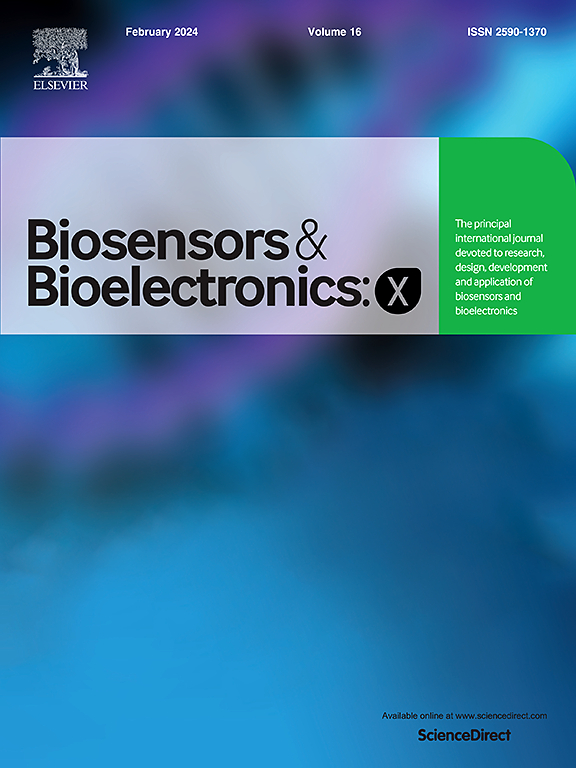Detecting age-related changes in faecal vasoactive intestinal polypeptide using a 3D-printed electrochemical immunosensor
IF 10.61
Q3 Biochemistry, Genetics and Molecular Biology
引用次数: 0
Abstract
Vasoactive intestinal polypeptide (VIP) is a 28-amino acid neuropeptide with a multitude of diverse physiological functions, including vasodilation, immune modulation, and most notable gastrointestinal regulation. At present, VIP is determined using biochemical assays, which are time-consuming and require complex multi-step sample preparation. Therefore, we focused on the development of the first electrochemical immunosensor for the detection of VIP in faecal pellets. Our VIP immunosensor was made by covalent immobilization of an anti-VIP antibody onto a thiophene-2-carboxylic acid conductive polymer layer, after deposition of gold nanostars onto a carbon black/polylactic acid 3D printed electrode. Scanning electron microscopy and electrochemical measurements confirmed layer-by-layer modification of the electrode to craft the VIP immunosensor. The immunosensor exhibited a linear range between 10 and 100 pM, with a limit of detection of 4.3 pM. The immunosensor was selective against electroactive compounds known to be present within the intestinal tract. We observed a reduction in VIP levels in faecal pellets from 24-month-old mice when compared to 12-month-old mice. This novel VIP electrochemical immunosensor can be an effective tool for diagnosis or prognosis of various diseases given the diverse physiological function of VIP.
利用3d打印电化学免疫传感器检测粪便血管活性肠多肽的年龄相关变化
血管活性肠多肽(VIP)是一种由28个氨基酸组成的神经肽,具有多种生理功能,包括血管舒张、免疫调节和最显著的胃肠调节。目前,VIP是通过生化分析来确定的,这种方法耗时且需要复杂的多步骤样品制备。因此,我们致力于开发首个用于检测粪便颗粒中VIP的电化学免疫传感器。我们的VIP免疫传感器是在炭黑/聚乳酸3D打印电极上沉积金纳米星后,将抗VIP抗体共价固定在噻吩-2-羧酸导电聚合物层上制成的。扫描电子显微镜和电化学测量证实了电极的逐层修饰,以制作VIP免疫传感器。该免疫传感器在10 ~ 100 pM之间呈线性范围,检测限为4.3 pM。该免疫传感器对已知存在于肠道内的电活性化合物具有选择性。我们观察到,与12个月大的小鼠相比,24个月大的小鼠粪便颗粒中的VIP水平有所降低。鉴于VIP的多种生理功能,这种新型VIP电化学免疫传感器可作为多种疾病诊断和预后的有效工具。
本文章由计算机程序翻译,如有差异,请以英文原文为准。
求助全文
约1分钟内获得全文
求助全文
来源期刊

Biosensors and Bioelectronics: X
Biochemistry, Genetics and Molecular Biology-Biophysics
CiteScore
4.60
自引率
0.00%
发文量
166
审稿时长
54 days
期刊介绍:
Biosensors and Bioelectronics: X, an open-access companion journal of Biosensors and Bioelectronics, boasts a 2020 Impact Factor of 10.61 (Journal Citation Reports, Clarivate Analytics 2021). Offering authors the opportunity to share their innovative work freely and globally, Biosensors and Bioelectronics: X aims to be a timely and permanent source of information. The journal publishes original research papers, review articles, communications, editorial highlights, perspectives, opinions, and commentaries at the intersection of technological advancements and high-impact applications. Manuscripts submitted to Biosensors and Bioelectronics: X are assessed based on originality and innovation in technology development or applications, aligning with the journal's goal to cater to a broad audience interested in this dynamic field.
 求助内容:
求助内容: 应助结果提醒方式:
应助结果提醒方式:


